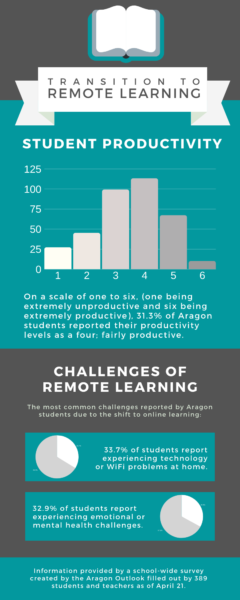On March 12, the San Mateo Union High School District announced online teaching would commence after the last day of in-person school on March 13. As schools begin their third week of online education, teachers and faculty strive to optimize their curriculums for online learning in order to uphold educational standards.
“Everybody’s dealing with all sorts of things that we just wouldn’t normally deal with,” said science teacher Kevin Doyle. “It’s difficult. I think as a school and as a district, we’re doing the best we can and it’s a pretty good job, but it’s not like having real school.”
Different fields of study require different methods of implementation, so they each must employ varying tactics to replicate the connection involved with educating that specific subject. Online learning isn’t a new concept, but implementing it statewide is an unprecedented challenge to modern education systems. Merriam-Webster defines distance learning as “a method of study where teachers and students do not meet in a classroom but use the Internet, e-mail, mail, etc., to have classes.”
Aragon Health teacher Justin Cottrell took three courses on E-learning design and development at San Francisco State University during the Fall 2019-2020 semester, and found that it helped prepare him for the transition to distance learning.
“It worked a lot of the same ways that we’re working now, with online meetings and such,” Cottrell said. These strategies have proven useful during school closures. “If this continues, I will start doing weekly live meetings.”
Platforms such as Zoom are proving as useful assets when making a transition to distance learning, but teachers can’t fully replicate the level of connection that a typical school day provides.
“I feel like it’s been pretty seamless,” Cottrell said. “I do miss being able to talk to all of my students every day. … I miss the connection aspect”
Students are the measure for the effectiveness of e-learning strategies. According to the Aragon Outlook COVID-19 School Survey, 57% of 363 students that participated claimed their grades generally haven’t changed. Teachers can log students’ grades and understand if they are viewing, completing and succeeding in their assignments through Canvas.
“I haven’t had too many snags with students, but it’s hard to know from an analytics page how well students are doing during this time,” Cottrell said.

Zoom, a video conference tool, is a popular choice for teachers who wish to host their classes online.
“Zoom’s face to face aspect adds a lot. Seeing my face and each other’s helps to make it feel as much like a classroom as it can, it creates that same dynamic and it helps,” said Cheri Dartnell, Aragon Math department co-head. Dartnell has been consistently using Zoom to teach her students.
To provide an easier transition to remote learning, some classes have altered the deadlines for assignments, or changed the assignments altogether. The unit that chemistry classes planned to teach had often been challenging for students when taught in previous years, so they focused on teaching a different, more accessible unit.
“Chemistry teachers decided to switch to working on climate change instead of thermal chemistry. For climate change there’s a module that has a lot of online references, so you’re not having to do the physical lab,” Doyle said. “It’s got data sets and information references as if you were analyzing things in labs.”
In addition to finding online simulation sources for chemistry labs, teachers must also determine how to administer tests.
“The district has been saying not to do tests during the shutdown,” Doyle said. “I do have a couple people who had to take a test before the shutdown, so I’m trying to figure out how to rewrite that.”
Aragon’s art classes conduct an exam each semester, but are always working on projects or filling up their sketchbooks. The beginning art students were assigned to complete sketchbook prompts, but the AP classes were to finish their large projects at home.
“I sent everyone home with their sketchbooks and then they’ve been taking pictures to upload to Canvas.” said art teacher Kathryn Katcher. “The biggest challenge has been knowing what supplies they have at home. I know they have their sketchbook and everybody has a pencil and probably a pen, but how many kids have markers or glue or colored pencils or those things that I hope they would have, but many of them do not.”
Music students also might not have the instruments at home to practice what they play in school, but if they don’t, they may borrow school materials. Before the school closure, music students would work in small sections as well as a large ensemble on group music, so the more pressing challenge was how the teacher and students were to communicate and interact with each other.
“Yearly our goals have been to prepare for [California Music Educator’s Association] festival and our Spring Concert,” said choir and orchestra director John Chen. These events are now cancelled due to COVID-19.
Music directors have taken to instructing their students to record themselves playing and submit it on Canvas. As of now, online ensemble rehearsals will not take place.
“Some students will practice four hours a day, but there’s no substitute for meeting face to face and elbow to elbow!” Chen said.
When the district was considering school shutdowns, students met face to face with their guidance counselors during their math classes. The guidance counseling department worked on piecing together the master spreadsheet of students’ classes for next year and they continue to do so. Because they can no longer meet during school, counselors contact students and their families through phone calls, Google Hangouts, emails and Aeries.
“We would be face to face doing these one on one meetings, so [Google Hangouts] is more impersonal,” said guidance counselor Lea Sanguinetti. “That’s why we wanted to continue those at home to make students feel like we are connecting with them on an individual basis.”
Including programming the students already at Aragon, the counselors also have to plan for the 450 incoming freshmen.
“Scheduling will probably look the most different for our incoming families,” Sanguinetti said. “They’re used to coming to an orientation night where we walk them through programming. Now we’re having to create a Google Form to send to families.”
School pushes students to take the initiative to keep learning and participating in meetings like these, despite not physically being in school. Since there is no longer a structure to students’ days, they must establish their own.
“I’ve been trying to set down a schedule where I do my classwork when I would normally have class,” said sophomore Emily Du. “That’s kind of hard to do, especially when there is nothing concrete to set your day up for.”
Many find at-home learning to be difficult, but 31% of 370 students that participated in the survey said they have been pretty productive online learning. This sudden transition to a new learning style teaches people how to develop a better approach to independent learning, a lesson important to everyone.
“Students will be experiencing online classes when they go to college,” said career and technical engineering counselor Helen O’Brien. “Having to learn independently is going to happen for the rest of your life. Whether it’s for a job, learning a new skill, or learning a new hobby, it’s a part of where we’re headed.”
While the implementation of online schooling teaches lessons about independence, it also teaches thankfulness for privileges that are challenged during quarantine.
“I think we’d all definitely be more grateful for school and realize that we took it for granted before,” Du said. “There’s newfound appreciation for the fact that we get education.”




